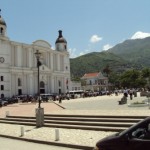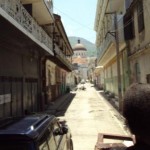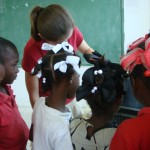Church, Cake, and Cells
Bonswa! Sunday was a very good day. It was Jocelyn’s twenty-first birthday. I gave her a card I made back in the states and a bag of Skittles I picked up in the Miami airport. Not much, but I think she really liked it. Also, it was nice to surprise someone who I spend every moment of every day with; it sort of felt like the feeling you get when the vending machine gives you two of what you wanted. It felt great to give her a gift, even a simple one, and the bonus was that it was a surprise.
We started off the day with breakfast at seven. Then we went back to our room to pack our bags for the journey to church. We shared a bag with the necessary items: camera, water bottles, money, granola bars, and sunglasses. Bags packed and ready to go, we left the school headed for Milot. We took the highway we know so well until we came to the so-called Intersection of Death. It sounds so ominous, but I really have no idea why they call it this; there is nothing really out of the ordinary about it. It is like a T. The long side is the road from Terrier Rouge. If you turn right at the Intersection of Death, you go towards Cap, the second largest city in Haiti after Port-au-Prince. If you turn left the road ends at Milot, where we were going. For those of you who are more directionally minded than myself, Milot is south of Cap along the coast. Also, a turn to the right allows you to travel on comfy asphalt, but turn to the left and you are in for a bumpy ride.
Dominique wanted to go to church in Milot because her friend Fabian was getting ordained. It was his first service. We got there late, as is usual for us and church. Church seems to be the only exception to Haitian time, meaning it actually starts when they say it is going to start. (I am starting to like this aspect of Haiti; they are much more easygoing.) It was so hot in the church, but it was very beautiful. Driving into the town, it was like you were in a little rain forest and then all of a sudden this big beautiful dome with a cross on top appeared out of nowhere.
That dome is the church. King Henri Christophe built the church and a beautiful palace in the early 1800’s. (Haiti became the first modern black republic in 1804.) The palace is now in ruins, but one can imagine what it must have looked like and the sheer size of the ruins is impressive. It was lovely.
After the service, we went to a party for the newly ordained priest. It was in this lovely courtyard. To get there you had to cross a little creek and climb up these really steep stone stairs and under palm fronds. I felt as if I could be discovering a long lost kingdom in an Indiana Jones movie.
On the way back from the church, we went to Cap to have lunch. We ended up going to a small fast food-like place. Next, we stopped at a bakery to get some goodies for Jocelyn’s birthday. As I opened the door, I noticed there was a man standing behind it. I quickly began to search my mental Creole dictionary for some type of polite apology when I noticed he had a gun. I stood there frozen in the door for a moment before I realized he was an armed guard paid to “protect” the cakes, creams, and croissants from the beggars standing outside. And that is when we saw them. The cakes were all different colors, pale pinks, sea foam greens, and lovely yellows with beautiful white flowers, hearts, and crosses. We each got to pick out our own slice. Jocelyn chose a yellow cake with icing that looked more sugary than sugar itself. Later she would tell me that she only chose it because the icing looked the best. I chose a marble cake with pale green icing and pink designs. It was the most beautiful cake I have ever seen, and one of the best I have ever tasted.
Yesterday we taught one second grade class and both third grade classes the water purification lesson and a brief introduction to cells. Once we explained what cells were, we asked the kids how many cells they thought we had. The answers included one, six, twenty-seven, two hundred fifty-six and one thousand. They were shocked when we told them it was millions.
Today Jocelyn and I taught our favorite lessons so far. It was very rewarding to see the kids engaged and interested in what we were teaching. We taught the older grades -4th, 5th, and 6th– about cells. We first talked about cell basics and then described five cells in detail, specifically red blood cells, white blood cells, neurons, muscle cells, and skin cells. We made each cell out of paper and held it up as we talked about them. We also used a diagram to explain what happens to cells when we are sick and how the white blood cells protect our bodies. Then we held up all the cell types and played a matching game. We would ask a question and the students would have to point to what kind of cell we described. Then we asked the class for a volunteer. We had a boy use a check swab so that they could see their own cells using the microscope Jocelyn described below. I think it really brought the message of the lesson home.
We are also teaching an English lesson later on today. Today we will cover seasons and weather. The teachers are such enthusiastic learners and very encouraging teachers! I am learning that I really like teaching and my Creole is definitely improving.






